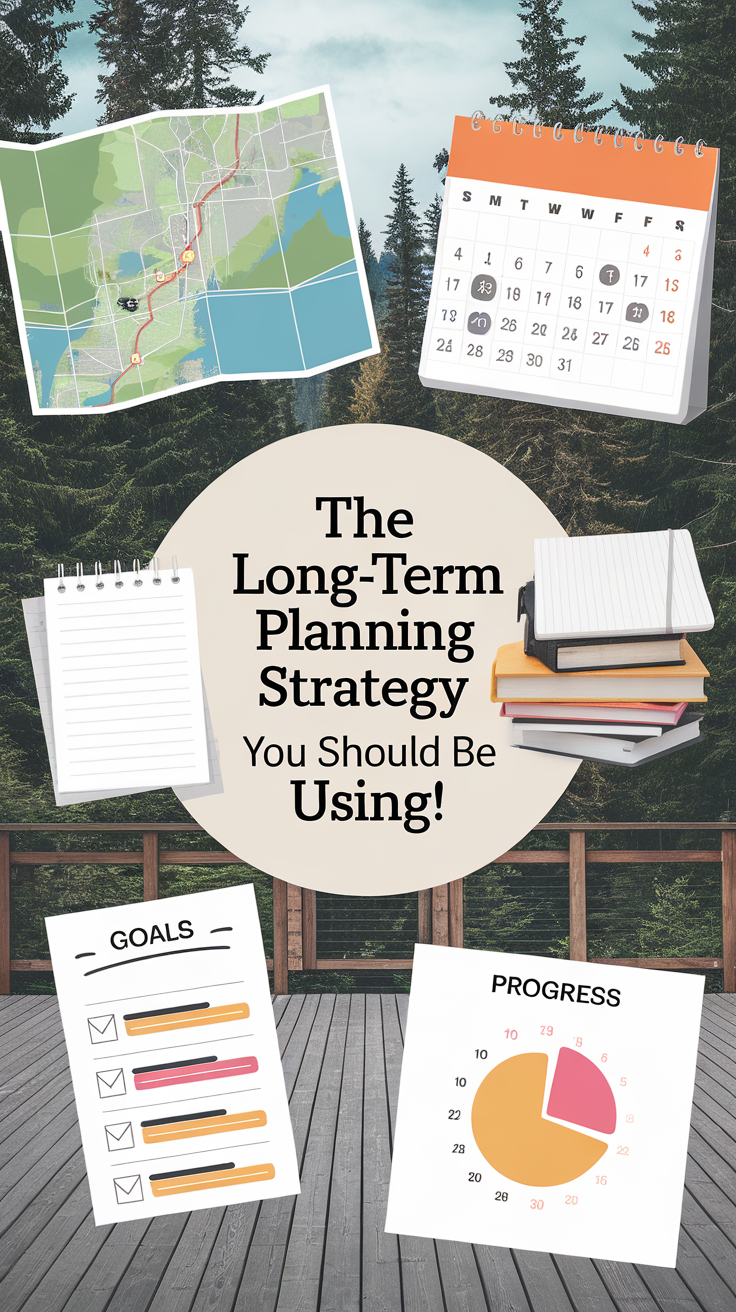Long-Term Planning Made Easy With These Tips!
Long-term planning doesn’t have to be overwhelming. Start by defining your goals clearly and categorizing them into short-term and long-term objectives. Break down milestones to create a structured roadmap, ensuring each phase has measurable targets. Prioritize tasks effectively to maintain focus, and establish a timeline with deadlines to foster accountability. Regularly monitor your progress and stay flexible enough to adapt to any changes that arise. Seeking support from accountability partners can enhance your commitment while collaborative insights minimize blind spots. There are additional strategies you can employ to refine your approach and boost your planning success.
Key Takeaways
- Set clear long-term goals using the SMART criteria to ensure they are specific, measurable, achievable, relevant, and time-bound.
- Break down long-term objectives into manageable milestones to track progress and maintain motivation throughout the planning process.
- Regularly review and adjust your plans to remain flexible and responsive to changing circumstances and priorities.
- Utilize collaboration and accountability partners to enhance commitment and gather diverse insights for effective decision-making.
- Document progress and findings to inform future strategies and identify patterns that can guide ongoing planning efforts.
Define Your Goals
How can you effectively define your goals to secure long-term success? Start by engaging in thorough goal setting that aligns with your personal vision. It’s crucial to articulate what you truly want to achieve, as vague aspirations lead to vague outcomes. Reflect on your values, strengths, and areas for growth—these insights will sharpen your focus and guarantee your goals resonate deeply.
Next, categorize your goals into short-term and long-term objectives. Short-term goals act as stepping stones, while long-term goals serve as your ultimate destination. This dual framework not only clarifies your path but also helps you assess progress over time.
Utilize the SMART criteria—specific, measurable, attainable, relevant, and time-bound—to refine each goal, ensuring they’re both actionable and realistic.
Lastly, visualize your success. An evocative mental image of your achievements can reinforce your commitment and drive. Regularly revisit and adjust your goals as necessary; flexibility in your strategy allows for growth and adaptation in the face of new challenges.
Break Down Milestones
Breaking down milestones is essential for translating your long-term goals into actionable steps. By doing so, you create a structured roadmap that facilitates goal tracking and guarantees you remain focused and motivated.
Here are three key strategies to effectively break down your milestones:
-
Identify Major Phases: Start by determining the significant phases of your project or goal. This allows you to outline what needs to be achieved over time.
-
Set Specific, Measurable Targets****: For each phase, establish specific targets that are quantifiable. This clarity enables you to track progress and adjust your strategies if necessary.
-
Incorporate Milestone Celebrations****: Recognizing and celebrating milestones as you reach them can enhance motivation and commitment.
These celebrations reinforce your progress, making the journey more enjoyable and fostering a positive mindset.
Create a Timeline
Creating a timeline is essential for tracking your progress and ensuring you stay on course.
You’ll want to set clear milestones that serve as checkpoints, allowing you to measure your achievements effectively.
Additionally, it’s vital to adjust for flexibility, as unexpected changes may require you to recalibrate your plans without losing sight of your long-term goals.
Set Clear Milestones
Setting clear milestones is essential for effective long-term planning, as it allows you to measure progress and maintain focus.
By implementing milestone markers, you can create a structured approach to your goals. Here are three critical aspects to take into account for effective milestone tracking:
-
Define Specific Goals****: Clearly outline what you want to achieve at each milestone. Specificity eliminates ambiguity, allowing for more precise tracking.
-
Set Timeframes: Assign realistic deadlines to each milestone. This creates a sense of urgency and helps you prioritize tasks effectively.
-
Monitor Progress: Regularly assess your progress against these milestones. This guarantees that you stay on course and can make informed adjustments to your plan when necessary.
Adjust for Flexibility
Flexibility is an essential component of any effective long-term planning strategy, enabling you to adapt to unforeseen changes and challenges. To create a timeline that incorporates this flexibility, start by outlining your primary objectives and their respective deadlines. However, make certain your timeline isn’t rigid; instead, design it to accommodate dynamic adjustments as circumstances evolve.
Incorporate adaptable strategies by segmenting your plan into phases. Each phase should have built-in review points, allowing you to assess progress and recalibrate if necessary. This way, you can identify potential obstacles early and pivot your approach accordingly.
Moreover, prioritize tasks based on urgency and importance, creating a hierarchy that can shift as new information emerges. This strategic prioritization makes certain that you’re not just reacting but proactively managing your objectives.
Lastly, consider the potential impact of external factors—market shifts, economic changes, or even personal demands. By anticipating these variables, you can fortify your planning against disruption, making certain your long-term vision remains intact despite the inevitable changes.
Emphasizing flexibility within your timeline empowers you to maintain momentum, ultimately leading you to success in an unpredictable landscape.
Prioritize Tasks
To effectively prioritize tasks, you need to distinguish between what’s urgent and what’s important; this helps you allocate your time wisely.
Setting clear deadlines for each task not only creates accountability but also fosters a sense of urgency.
Finally, breaking down larger tasks into manageable steps makes the entire process less intimidating and more achievable.
Identify Urgent vs. Important
Understanding the distinction between urgent and important tasks is essential for effective long-term planning. By mastering this differentiation, you can streamline your focus and enhance productivity.
Here are three key strategies to contemplate:
-
Utilize the Importance Matrix****: Categorize tasks based on urgency and importance. This will help you visualize where your efforts should be concentrated.
-
Evaluate Urgent Decisions*: Not all urgent tasks contribute meaningfully to your *long-term goals. Assess whether these urgent decisions align with your priorities or merely distract you.
-
Prioritize Wisely: Focus on tasks that are both urgent and important first, followed by important but not urgent items. This strategy allows you to prevent crises while working towards your overarching objectives.
Set Clear Deadlines
Setting clear deadlines is vital for effective task prioritization and overall productivity. When you establish realistic timelines, you enhance your deadline management skills, allowing for better focus and execution. It’s important to take into account the complexity of each task and allocate time accordingly.
Here’s a simple table to help you visualize your prioritization:
| Task | Deadline | Priority Level |
|---|---|---|
| Project A | MM/DD/YYYY | High |
| Project B | MM/DD/YYYY | Medium |
| Project C | MM/DD/YYYY | Low |
Break Down Tasks
Breaking down tasks into smaller, manageable components can considerably enhance your ability to prioritize effectively. By employing task segmentation, you allow yourself to focus on specific elements rather than feeling overwhelmed by the entirety of a project.
This method not only clarifies your objectives but also fosters a sense of accomplishment as you complete each segment.
To effectively break down tasks, consider the following:
- Identify Key Milestones****: Determine the major phases of your project to understand the broader goals.
- Create Manageable Chunks****: Divide each milestone into smaller, actionable steps that can be tackled individually.
- Set Priorities: Rank these chunks based on urgency and importance, ensuring that critical tasks are completed first.
Monitor Progress
Monitoring progress is vital for guaranteeing that your long-term plans remain on track and aligned with your goals. To effectively monitor your progress, implement a robust progress tracking system. This involves setting specific metrics that directly correlate with your objectives. By quantifying your achievements, you create a tangible framework to evaluate performance.
Regular performance evaluation is important in this process. Schedule consistent intervals—be it weekly, monthly, or quarterly—to assess your advancement. During these evaluations, compare your current standing against your established benchmarks. This will help you identify areas of success and those requiring improvement.
Additionally, be meticulous in documenting your findings. A detailed record not only provides insights for future planning but also helps in recognizing patterns over time. Make sure to analyze both qualitative and quantitative data to gain a thorough view of your progress.
Finally, remain proactive in addressing any discrepancies between your plans and actual performance. By doing so, you’ll guarantee that your long-term strategies remain relevant and effective, ultimately steering you toward achieving your goals with greater precision.
Stay Flexible
Even with a solid progress tracking system in place, adapting to change is just as important. Long-term planning requires you to remain agile, ready to pivot when circumstances warrant.
Here are three essential adaptable strategies to enhance your responsive planning:
-
Regularly Review Your Goals: Reassess your objectives at predetermined intervals. This allows you to identify shifts in priorities or market conditions that might necessitate a change in direction.
-
Embrace Feedback Loops: Create mechanisms for obtaining real-time feedback from stakeholders. By actively listening to insights and concerns, you can adjust your strategies accordingly, ensuring alignment with evolving needs.
-
Diversify Your Approaches: Relying on a single strategy can be detrimental. By employing a variety of approaches, you enhance your ability to respond effectively to unforeseen challenges and opportunities.
Incorporating these adaptable strategies into your long-term planning framework not only cultivates resilience but also positions you as a proactive leader.
Seek Support
Seeking support is essential for successful long-term planning, as collaboration can greatly enhance your strategies and outcomes. Engaging with collaborative networks allows you to tap into diverse perspectives and expertise, providing a multifaceted approach to problem-solving.
When you surround yourself with individuals who share similar goals, you create an environment conducive to innovation and strategic thinking.
Establishing accountability partners can greatly elevate your commitment to your plans. These partners can challenge you to stay on track, helping you navigate obstacles that may arise. Regular check-ins foster a culture of accountability, ensuring that you consistently evaluate your progress and adjust your strategies as necessary.
Moreover, the insights gained from collaborative discussions can reveal blind spots in your planning, prompting you to reflect on alternative solutions. The synergy created through collaboration not only enhances your decision-making process but also motivates you to persist in your pursuits.
Frequently Asked Questions
How Do I Stay Motivated During Long-Term Planning?
Staying motivated during long-term planning can be challenging, but engaging accountability partners and employing visualization techniques can greatly enhance your focus. Analyze your goals regularly, adjusting strategies to maintain momentum and foster commitment to your vision.
What Tools Can Help With Long-Term Planning?
For effective long-term planning, you should consider digital planners that streamline organization and enhance productivity. Additionally, goal tracking tools can help you monitor progress, adjust strategies, and guarantee alignment with your overarching objectives.
How Often Should I Revisit My Long-Term Goals?
You might think once is enough, but regularly revisiting your long-term goals guarantees effective goal assessment and necessary timeline adjustments. Aim for quarterly reviews to stay aligned with evolving circumstances and maintain strategic focus.
What if My Priorities Change Unexpectedly?
If your priorities change unexpectedly, employ priority reassessment strategies. Regularly evaluate your goals and adapt plans effectively to align with your current values, ensuring you maintain focus and optimize your efforts towards meaningful achievements.
How Can I Involve Others in My Planning Process?
Involving others in your planning process is like weaving a tapestry; each thread adds depth. Engage in collaborative brainstorming and schedule feedback sessions to harness diverse insights, ensuring your plan reflects collective wisdom and adaptability.



